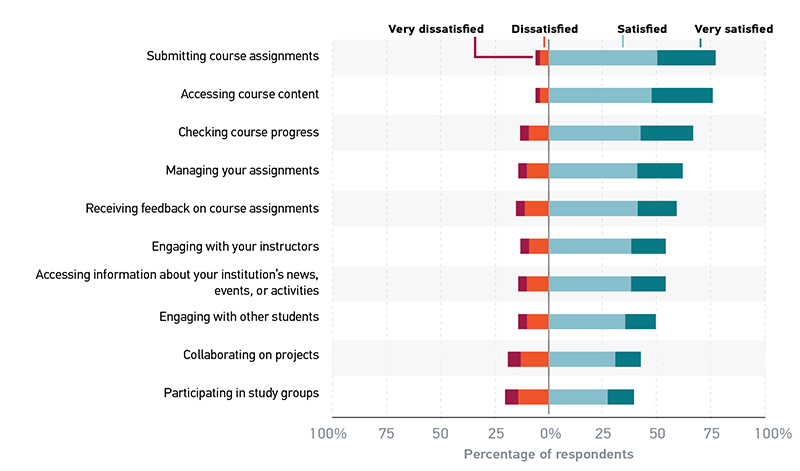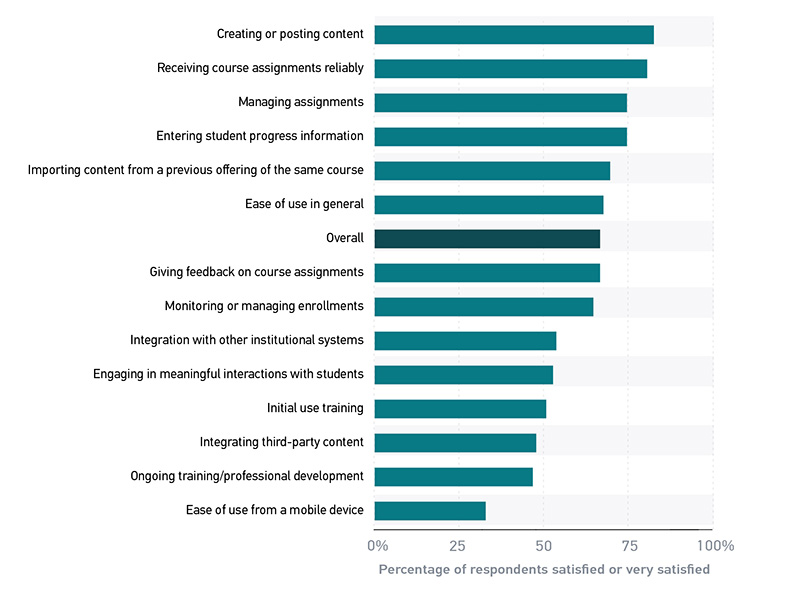Satisfaction with LMS Functionality
Satisfaction among students and faculty with features of the LMS—the subject of this section—reveals a pattern suggestive of both the limitations of the tool itself and the training faculty receive to use the LMS as a learning tool instead of a course management tool.
Although students are satisfied with the LMS implemented at their institution, there is a clear division in the level of student satisfaction between the basic functions of an LMS and its more sophisticated features (see figure 3). A majority of students are either satisfied or very satisfied with the course management functions of the LMS: submitting assignments (77%), accessing course content (75%), checking course progress (66%), managing assignments (62%), and receiving feedback on assignments (59%). The greater the level of engagement required of the student, however, the lower the level of student satisfaction with the LMS: engaging instructors (54%), accessing information about the institution's news, events, or activities (54%), engaging with other students (49%), collaborating on projects (43%), and participating in study groups (40%).

As discussed above, most faculty agree or strongly agree that the LMS is critical to their teaching. Peering more closely, however, we find that what faculty find critical and most satisfying are functions that enable asynchronous interaction: pushing out documents such as a syllabus and handouts, pushing out and collecting assignments, and posting grades in the gradebook. These are the same operational, course-management functions of the LMS with which students are most satisfied (see figure 4). Not quite half (45%) of faculty use the LMS to promote interaction outside the classroom by using discussion boards, and only about half (53%) of faculty are satisfied or very satisfied with the LMS as a tool for engaging in meaningful interactions with students.

Prior to the advent of the LMS, some faculty posted course content to the web; prior to the advent of the web, some faculty posted grades on sheets of paper outside their office doors. These operational, course management functions are nothing new; faculty have been using whatever tools are available to perform these functions since there have been faculty. The fact that the LMS is now used so widely by faculty to perform these functions shows the extent to which the LMS has become simply infrastructural in higher education. These functions are fundamental to teaching and learning, and the vast majority of faculty are using the LMS to accomplish them.
So, where does this put us? We have the tools in place. We have both faculty and students widely adopting the LMS. We have both faculty and students preferring blended learning and believing in its ability to improve student learning outcomes. We know that both students and faculty have developed sophisticated preferences for what they do in different learning environments. And, we have faculty and students largely satisfied with the LMS as a utility with which to manage their teaching and learning. These are important milestones in the world of educational technology. What we seem to be struggling with are the next steps—how do we leverage this knowledge, enthusiasm, and end-user buy-in to enhance and improve teaching and learning? This is the subject to which we now turn.